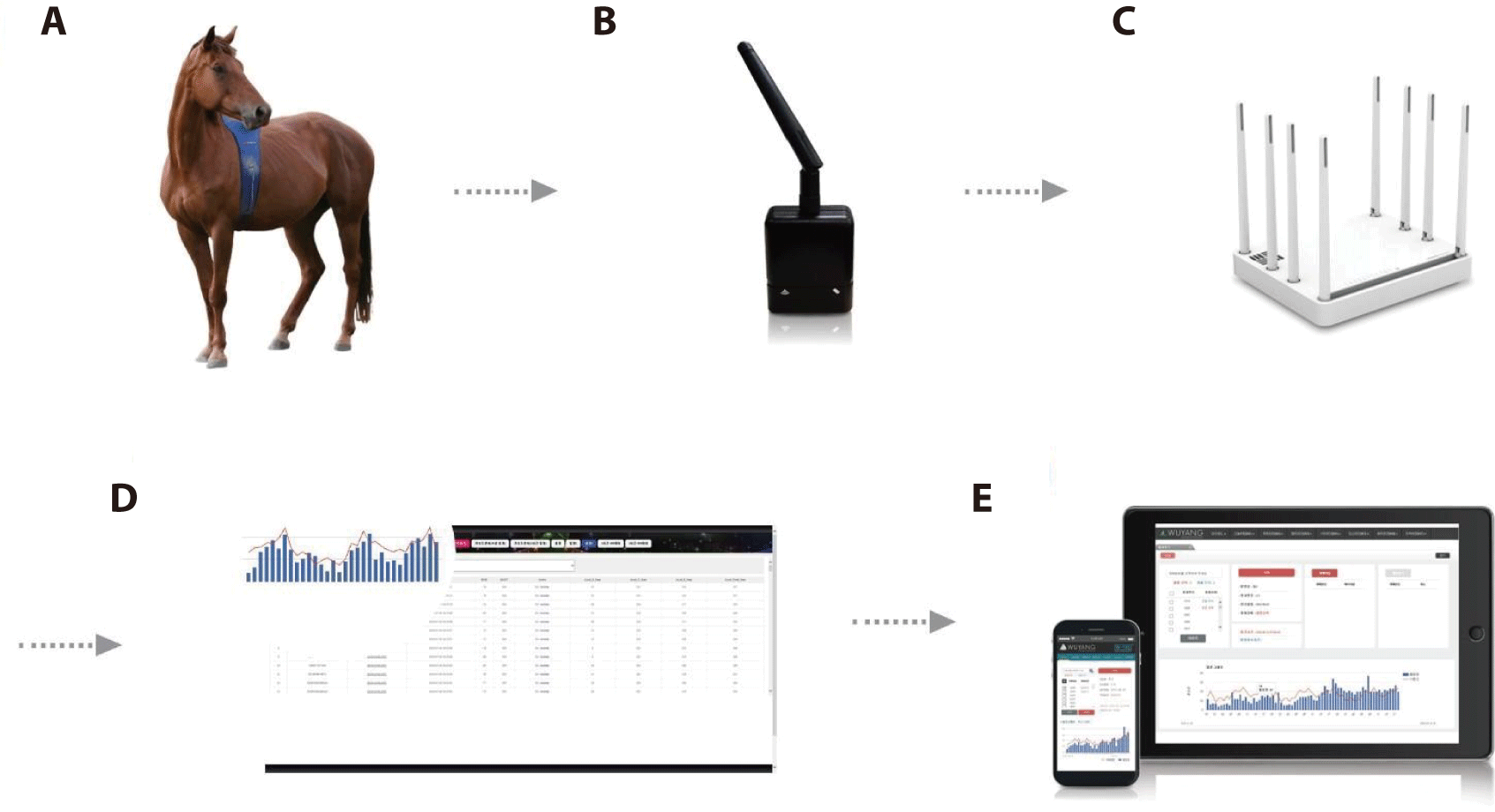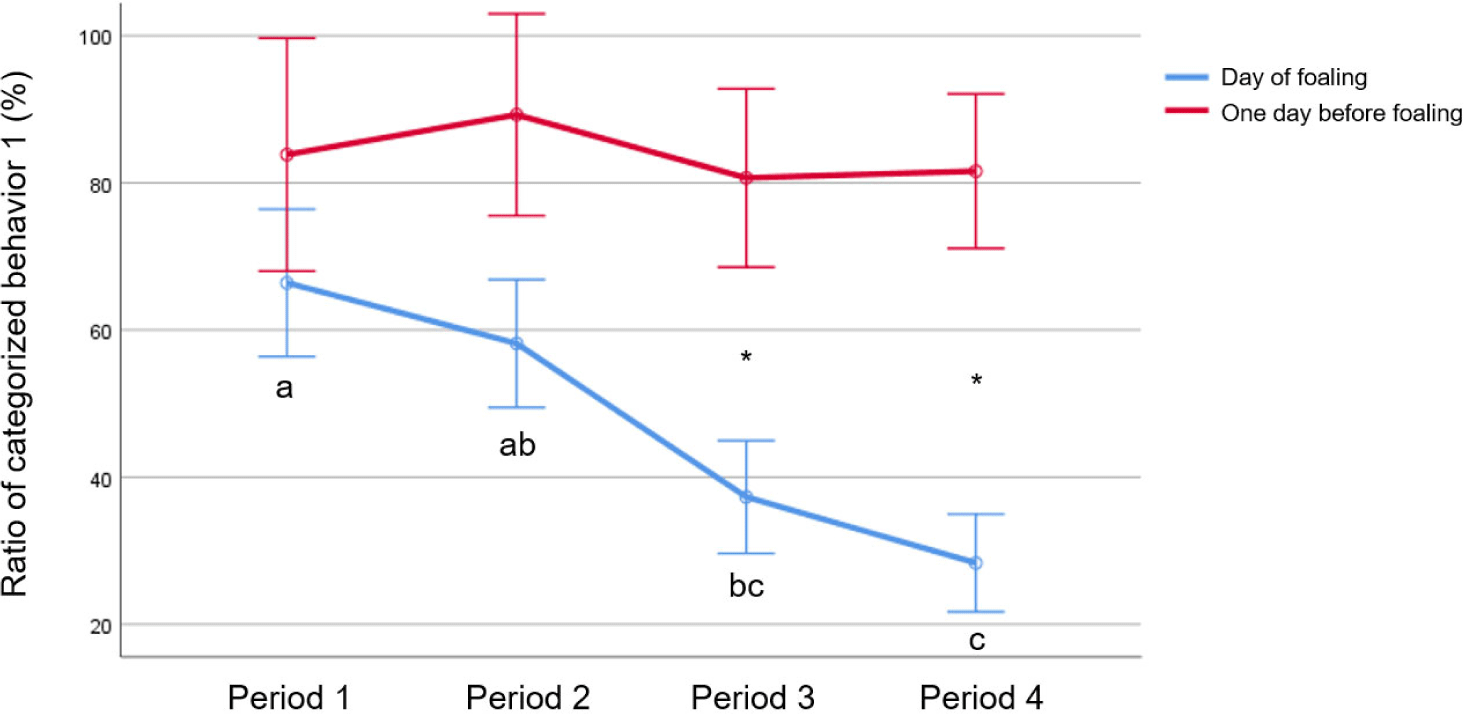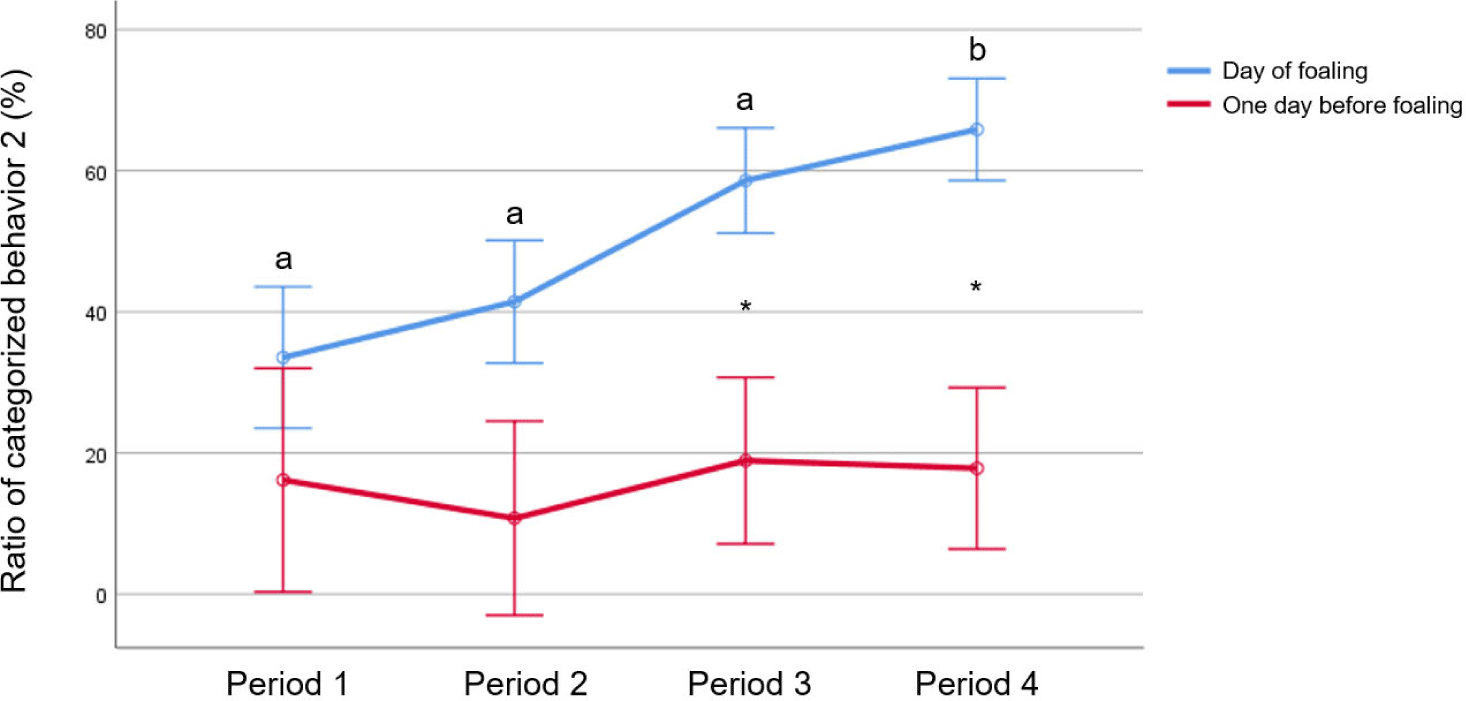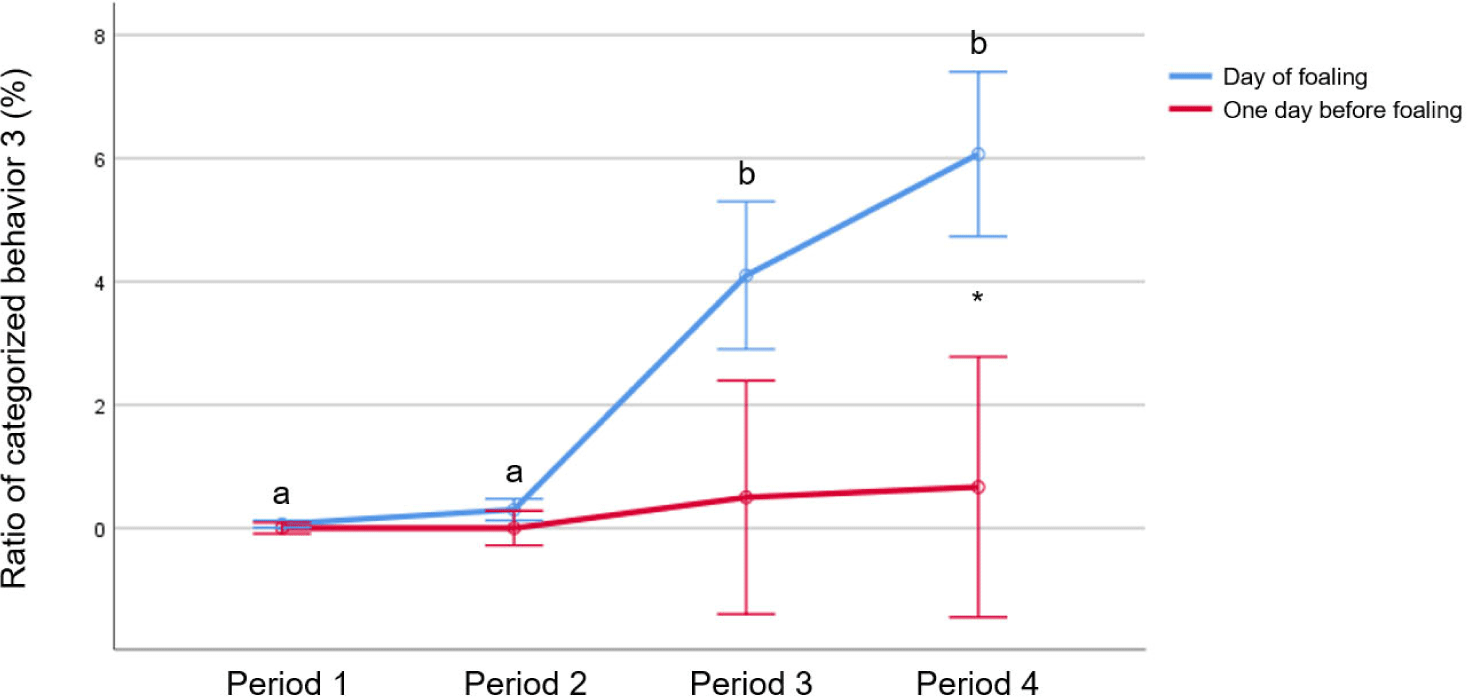INTRODUCTION
Predicting foaling onset is beneficial to assist mares experiencing dystocia. In Thoroughbred mares, breeders often fail to assist the foaling process because 86% of the foaling events occur between 19:00 and 7:00 [1]. To prevent dystocia, several foaling detection systems have been developed and applied for precisely predicting foaling time. However, these systems are not without shortcomings. One of the most popular systems, Foalert™, detects the discharge of amniotic fluid at the end of the first trimester; however, a shortcoming of this system is that the device must be surgically attached to the vulva, and if the attachment site is infected, the sensor must be detached to prevent its further spread. Smart Foal™ is another popular foaling detection system, which senses sitting down and standing up behaviors; however, the shortcoming of this system is that the sitting down and standing up behaviors are not specific to the pre-foaling period and are also observed when horses have colic or when they are scratching and resting. In addition, horses typically sit down and roll when new bedding is provided in the stall. Therefore, this system often erroneously detects foaling under normal conditions. To prepare for foaling, a foaling alarm system that operates at a precise time and with high accuracy is essential. Specifically, at the onset of the first trimester, the system should notify foaling signs, such that assistance can be provided without delay. In addition, the system should be easily applicable, such that it can be operated by breeders without the assistance of a professional veterinarian. Therefore, an innovative highly accurate and easy-to-use foaling alarm system must be developed.
Before foaling, the frequency of walking and lateral and sternal recumbency behaviors significantly increases, whereas the frequency of eating and standing behaviors significantly decreases [2]. Furthermore, during the pre-foaling period, mares tend to exhibit behaviors, such as standing, weaving, defecation, lowering the head, sitting down and standing up, and pawing, more frequently. Conversely, eating time is significantly reduced on the day of foaling compared with that two days before foaling [3]. Auclair-Ronzaud et al. [4] investigated behavioral changes in pregnant mares using an accelerometer attached to the tail and recorded increased frequency but shortened duration of tail movement before foaling. Collectively, these reports indicate that the time of foaling onset can be predicted by observing behavioral changes prior to foaling. In this context, monitoring pre-foaling behaviors using an accelerometer can be useful to develop a foaling alarm system. To this end, the present study aimed to (1) develop a novel foaling alarm system with an accelerometer sensor and (2) compare its accuracy with that of the existing foaling alarm system, Foalert™.
MATERIALS AND METHODS
To collect behavioral data, six horses (8.8 ± 3.2 years old) of the Thoroughbred, Haflinger, and pony breeds were included. The horses were housed in 3.5 × 3.5 m2 stalls. Timothy hay (1.6% of body weight) and concentrate (0.4% of body weight) were supplied three times and once a day, respectively. Water was provided ad libitum.
The present study was conducted at the Domestic Animal Research Facility of Kyungpook National University, Sangju, Korea. The study protocol was reviewed and approved by the Animal Experimentation Ethics Committee of Kyungpook National University (permit number: 2020-0140).
In the present study, a 3D accelerometer sensor (iBS03, Ingics Technology, New Taipei City, Taiwan; 43 × 43 × 14.8 mm3) was used to measure behavioral data. The sensor attached to each horse collected triaxial acceleration data on behavior and transmitted these to a database server (Wuyang, Jeonju, Korea) through a gateway (IGS1S, Ingics Technology). Horse behavior was recorded for 2 h using a camera. The behaviors were classified into state (lateral recumbency, sternal recumbency, standing, walking, and eating) and frequent (defecation, urination, pawing, and rolling) behaviors. Numerical data were collected for each behavior.
Eighteen Thoroughbred mares (11.9 ± 4.0 years old) were included to measure the acceleration values of pre-foaling behaviors. The mares were grazed during the daytime and housed in 3.5 × 3.5 m2 stalls during the nighttime. Water and hay were provided ad libitum, and concentrate was supplied twice a day. The mares were managed at three racing horse breeding farms on the Jeju Island, Korea. The study protocol was reviewed and approved by the Animal Experimentation Ethics Committee of Kyungpook National University (permit number: 2022-0027-1).
Behavioral data of the pregnant mares were collected using an accelerometer (Fig. 1). The gateways that transmitted behavioral data from the sensor to the database server were installed near the stall. The triaxial acceleration data were transmitted every second, collated in the database server, and classified into categorized behaviors every 10 min. The duration of each categorized behavior was measured by the foaling alarm system every 10 min. The alarm was transmitted to the breeders when foaling was detected. To identify differences in the duration of each categorized behavior, behaviors monitored on the day of foaling were compared with data on the one day before foaling. The mean frequency of each categorized behavior observed for 10 min was obtained from 40 min before foal discharge; data were obtained from 40 to 30 min (period 1), from 30 to 20 min (period 2), from 20 to 10 min (period 3), and the last 10 min (period 4). To confirm the accuracy of the foaling alarm system, its foaling detection time was compared with that of Foalert™ (Acworth, GA, USA). Pregnant mares close to the foaling date were equipped with a wearable foaling alarm device starting at 19:00. The wearable device was removed when the mares were in the pasture during the daytime.

Statistical analyses were performed using SPSS version 26 (IBM). Changes in the behavior of mares before foaling were assessed using repeated-measures analysis of variance (ANOVA). Post-hoc test with least significant difference was applied to compare the durations of categorized behaviors during the same period between the day of foaling and the one day before foaling. Differences in the durations of categorized behaviors among the four periods were assessed. In addition, Mann–Whitney U-test was applied to compare the foaling alarm time between the novel foaling alarm system and Foalert™. A p < 0.05 was considered statistically significant.
RESULTS
Horse behaviors were classified into three categories according to the degree of body rotation (Table 1). The X-, Y-, and Z-acceleration data were substituted into functional equations and classified into three categorized behaviors. The functional equations for the three categorized behaviors were as follows: categorized behavior 1 = −167.335 + 0.579 × X + 0.306 × Y + 1.199 × Z; categorized behavior 2 = −155.403 + 0.499 × X + 0.369 × Y + 1.141 × Z; and categorized behavior 3 = −102.379 + 0.609 × X + 0.199 × Y + 0.759 × Z. The classification accuracy for the three categorized behaviors was 99.98% (i.e., 1 out of 5,442 data points was misclassified).
All mares included in the present study foaled from 19:00 to 5:00. The highest percentage of foaling (33.3%) was recorded during 21:00–22:00, followed by 23:00–00:00 (22.2%) (Table 2).
The duration of each categorized behavior was observed from 40 min before the time of foal discharge, and these data were compared with data collected on the one day before foaling (n = 6 mares). Moreover, the durations of categorized behaviors observed during different periods (1–4) on the same day were compared. The duration of categorized behavior 1 in periods 3 and 4 was significantly shorter on the day of foaling than on the one day before foaling. On the day of foaling, the duration of categorized behavior 1 was significantly shorter in periods 3 and 4 than in period 1. On the one day before foaling, however, there were no significant differences in the durations of categorized behaviors among the four periods (Fig. 2). Furthermore, the duration of categorized behavior 2 in periods 3 and 4 was significantly longer on the day of foaling than on the one day before foaling. On the day of foaling, the duration of categorized behavior 2 was significantly longer in period 4 than in the other periods. On the one day before foaling, however, there were no significant differences in the durations of categorized behaviors among the four periods (Fig. 3). Finally, the duration of categorized behavior 3 in period 4 was significantly longer on the day of foaling than on the one day before foaling. On the day of foaling, the duration of categorized behavior 3 was significantly longer in periods 3 and 4 than in periods 1 and 2. On the one day before foaling, however, there were no significant differences in the durations of categorized behaviors among the four periods (Fig. 4).



The novel foaling alarm system detected foaling 32.6 ± 17.9 min before foal discharge. Meanwhile, Foalert™ transmitted a foaling alarm 8.6 ± 1.0 min before foal discharge (Table 3). There was no significant difference in alarm time between the two systems. Notably, both systems failed to detect foaling in one of the eighteen mares (detection rate = 94.4%). In this case, the novel foaling alarm system missed foaling because the mare foaled while standing and Foalert™ missed foaling because it failed to monitor amniotic fluid discharge.
| Foaling alarm system | FoalertTM | |
|---|---|---|
| Alarm time (min) | 32.6 ± 17.9 | 8.6 ± 1.0 |
DISCUSSION
In the present study, the pre-foaling behavior of mares was successfully detected using an accelerometer sensor. Recently, accelerometers have been frequently used to monitor and collect animal behavioral data. For instance, De Waele et al. [5] developed an algorithm based on data collected using an accelerometer sensor attached to the halter; the system detected the onset of the second stage of foaling. In another study, Hartmann et al. [6] used an accelerometer sensor attached to the halter and measured acceleration data from 120 min before foal discharge; the authors noted that acceleration was significantly higher during 0–30 min than during 90–120 min before foal discharge. From these reports, accelerometers are useful tools to detect the pre-foaling behaviors of mares. Interestingly, in the present study, both systems applied failed to detected foaling in one of the eighteen mares (5.6%); this was because the concerned mare did not exhibit typical foaling behaviors, such as rolling and lateral recumbency. To prevent such misses, an additional sensor such as an altitude sensor can be introduced to the foaling alarm system.
Furthermore, we noted differences in the durations of categorized behaviors between the day before and the day of foaling. Specifically, the duration of abnormal behaviors significantly increased from the last 20 min until foal discharge. The duration of categorized behaviors 2 and 3 was significantly longer on the day of foaling than on the one day before foaling. Rolling behavior is a sign of abdominal pain due to colic and foaling [7]. In addition, lateral recumbency is considered a foaling-specific behavior. Typically, mares lie sideways such that their flanks contact the ground when amniotic fluid is discharged. Shaw et al. [2] observed that the frequency of lateral recumbency behavior significantly increased during the night of the foaling day, which is consistent with our observations. Therefore, the criterion of behavior categorization used in the present study can be applied to develop algorithms for foaling alarm systems.
Furthermore, to assess its accuracy, alarm time was compared between the novel foaling alarm system and Foalert™. Based on foaling behavioral data from the pilot experiment, the novel foaling alarm system was designed to transmit an alarm when the duration of both categorized behaviors 2 and 3 was over 12.9% and that of categorized behavior 3 was over 1% during 10 min. As a result, there was no significant difference in alarm time between the two systems, but the novel foaling alarm system tended to transmit the alarm earlier than that of Foalert™. Moreover, the detection rate of both systems was 94.4%. Therefore, the novel foaling alarm system exhibited comparable accuracy to Foalert™. Another advantage of the novel foaling alarm system is that the sensor can be attached without any surgical intervention. In addition, because the foaling alarm is transmitted via an Internet router, managers can receive the alarm regardless of the distance from the stall. In addition, the system detects the foaling behavior of mares every 10 min; thus, the managers can periodically receive alarms even when dystocia persists. Occasionally, Foalert™ can fail to detect the foaling process if the sensor is detached when mares rub their hindquarters against a wall. In contrast, the novel foaling alarm system cannot be easily detached. Overall, the novel foaling alarm system can serve as an alternative to Foalert™.
In conclusion, the novel foaling alarm system with an accelerometer sensor can assist breeders by detecting the onset of foaling. Furthermore, it may be used as a clinical device to monitor the status of health of horses.
